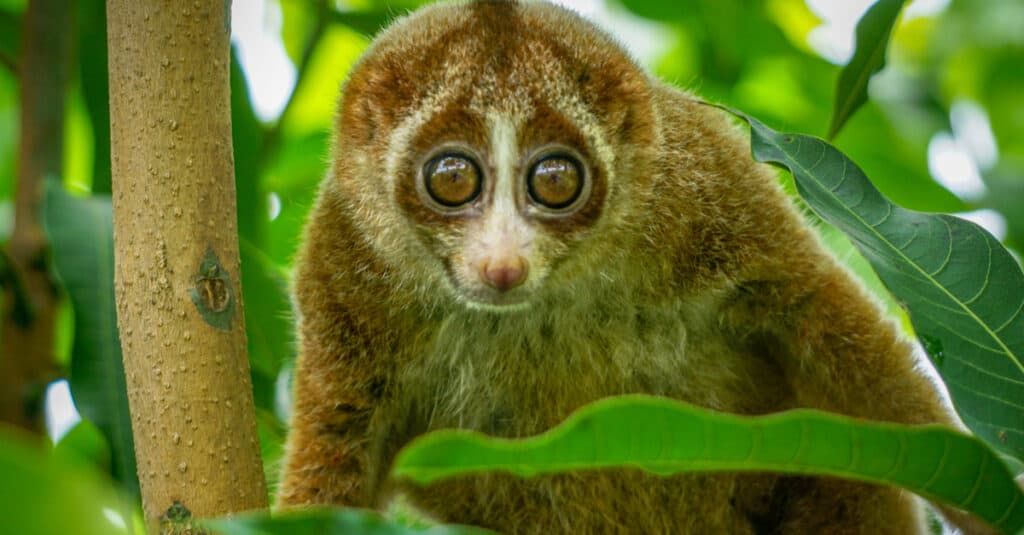When we think of venomous creatures, our minds normally gravitate towards creatures like snakes and spiders, but incredibly, there are some rare species of primates that pack a powerful bite. A recent clip shows an extremely rare primate as it climbs through the trees in a remote part of southern China. Meet the slow loris.
Rare “Venomous” Primate Spotted in China
The video brings some attention to one of the strangest groups of animals in the world. The animal in question? A slow loris, a small nocturnal primate (a relative of a monkey) that lives in the forests of Southeast Asia. The slow loris is also the only venomous primate in the world, giving us some insights into the evolutionary past of primates and humans.
The video clip is pretty straightforward. From the looks of things, someone walking nearby spotted the slow loris and started filming it on their phone. It has a somewhat “sloth-like” appearance, although it’s distinctly more “monkey-like” than a sloth. Sightings of slow loris are extremely rare, a testament to the issues the species is facing with deforestation and other survival threats.
Is the camera operator in danger? Probably not. While slow lorises do pack some punch with their bite, they aren’t aggressive and prefer to hide rather than go on the offensive.
The World’s Only Venomous Primate

There exists one known group of venomous primates in the world, the slow loris.
©Conservationist/Shutterstock.com
The slow loris belongs to a group of primates called strepsirrhines, which are more closely related to lemurs than to monkeys or apes. There are eight species of slow lorises, and unfortunately, all of them are classified as vulnerable, endangered, or critically endangered by the International Union for Conservation of Nature (IUCN). The slow loris in the video is probably the pygmy slow loris (Nycticebus pygmaeus), which has a native range across China, Vietnam, Laos, and Cambodia.
The slow loris is rather unique-looking among other primates. Its most distinctive feature is probably its large eyes (that help it see in the dark), but it also has a round head, flat face, and short snout. It also has a special toothcomb that it uses to groom itself and its mate. They get their names from their slow, methodical movement through the trees, although they can move quite a bit faster when they need to.
How Does Slow Loris Venom Work?

A slow loris will lick its arm to gather a toxic secretion in its mouth, which it then activates with its saliva, ready for use in a potent bite.
©hkhtt hj/Shutterstock.com
The most remarkable feature of the slow loris is its venomous bite. The venom of the slow loris comes from a gland under its arm. The gland releases a toxic substance, but it requires “activatation” to be potent. When the slow loris feels a threat, it will lick its gland and mix the secretion with its saliva, which creates a venomous concoction that it use for defense. The slow loris will then bite its attacker, injecting the venom into the wound. The venom can cause severe pain, swelling, infection, and allergic reactions in humans and other animals. The active “ingredient” is sometimes likened to the protein that comes from cat allergens, but it could also be strengthened by diet. Some people have died from slow loris bites.
There are several beliefs towards the use of venom of the slow loris. It was initially thought that it was a defense mechanism, but further research shows that it may be used more for internal disputes.
Sliding Towards Extinction

Unfortunately, the slow loris is on the verge of extinction in many of its habitats.
©hkhtt hj/Shutterstock.com
The slow loris is illegally traded all over the world. Many people capture and sell them as pets, unaware or indifferent to their conservation status and just viewing them as “cute”. They are terrible as pet. Furthermore in captivity, they often experience cruel practices, with the most common including having its teeth removed or clipped to prevent biting. On top of the physical cruelty, the slow loris also require a specific diet, environment, and social interaction that are difficult to provide in captivity. Most of the captive slow lorises die from stress, malnutrition, infection, or injury.
As it stands, slow lorises need help from humans to survive long-term, with several organizations are working to rescue and rehabilitate slow lorises from illegal trade and release them back into the wild. Popularity across YouTube has made them highly prized and traded, but these incredibly interesting animals deserve to be at home in the wild.
The photo featured at the top of this post is © Conservationist/Shutterstock.com
Thank you for reading! Have some feedback for us? Contact the AZ Animals editorial team.






